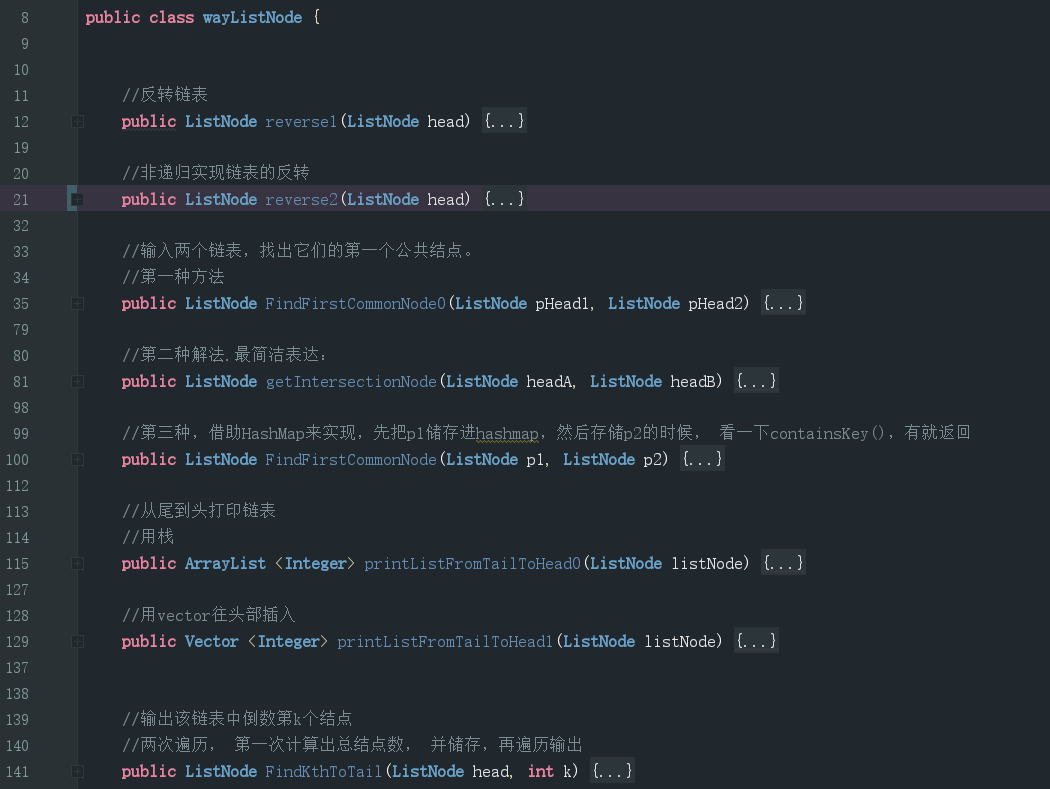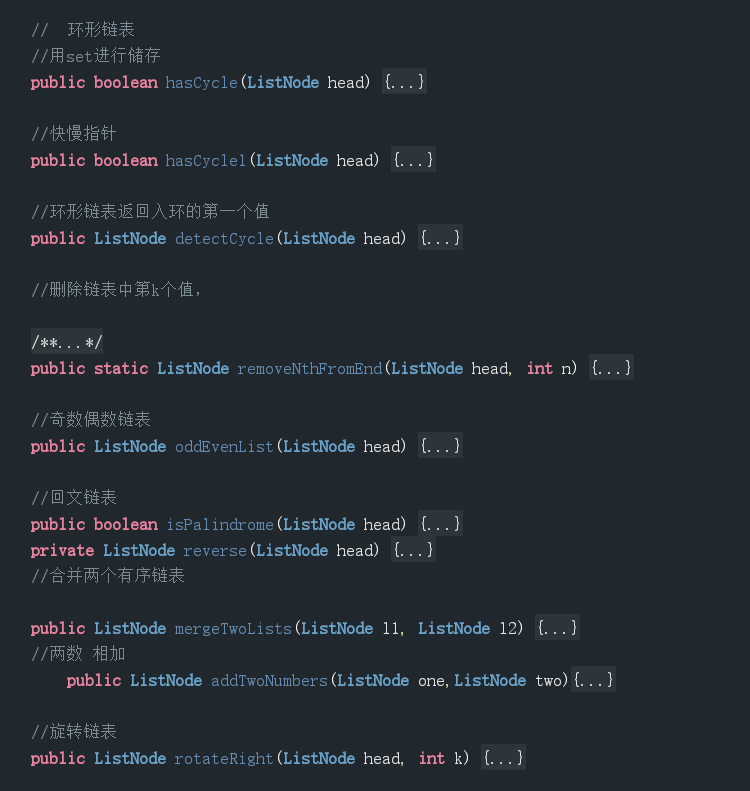清明节做了leetcode上面所有的算法题目:封装了工具类,以后常用算法可以快速实现;


代码:

import java.util.*; /** * @Author liguo * @Description */ public class wayListNode { //反转链表 public ListNode reverse1(ListNode head) { if (head.next == null) return head; ListNode newHead = reverse1( head.next ); head.next.next = head; head.next = null; return newHead; } //非递归实现链表的反转 public ListNode reverse2(ListNode head) { if (head == null) return head; ListNode next, pre =null; while (head != null) { next = head.next; head.next = pre; pre = head; head = next; } return pre; } //输入两个链表,找出它们的第一个公共结点。 //第一种方法 public ListNode FindFirstCommonNode0(ListNode pHead1, ListNode pHead2) { if (pHead1 == null || pHead2 == null) { return null; } //遍历找到长度 int count1 = 0; ListNode p1 = pHead1; while (p1 != null) { p1 = p1.next; count1++; } int count2 = 0; ListNode p2 = pHead2; while (p2 != null) { p2 = p2.next; count2++; } //计算长度,让长的走长度差个单位 int flag = count1 - count2; if (flag > 0) { while (flag > 0) { pHead1 = pHead1.next; flag--; } while (pHead1 != pHead2) { pHead1 = pHead1.next; pHead2 = pHead2.next; } return pHead1; } if (flag <= 0) { while (flag < 0) { pHead2 = pHead2.next; flag++; } //移动到找相等 while (pHead1 != pHead2) { pHead2 = pHead2.next; pHead1 = pHead1.next; } return pHead1; } return null; } //第二种解法.最简洁表达: public ListNode getIntersectionNode(ListNode headA, ListNode headB) { /** 定义两个指针, 第一轮让两个到达末尾的节点指向另一个链表的头部, 最后如果相遇则为交点(在第一轮移动中恰好抹除了长度差) 两个指针等于移动了相同的距离, 有交点就返回, 无交点就是各走了两条指针的长度 **/ if (headA == null || headB == null) return null; ListNode pA = headA, pB = headB; /** *在这里第一轮体现在pA和pB第一次到达尾部会移向另一链表的表头, 而第二轮体现在如果pA或pB相交就返回交点, 不相交最后就是null==null */ while (pA != pB) { pA = pA == null ? headB : pA.next; pB = pB == null ? headA : pB.next; } return pA; } //第三种,借助HashMap来实现,先把p1储存进hashmap,然后存储p2的时候, 看一下containsKey(),有就返回 public ListNode FindFirstCommonNode(ListNode p1, ListNode p2) { HashMap <Integer, Integer> hashMap = new HashMap <>(); while (p1 != null) { hashMap.put( p1.val, null ); p1 = p1.next; } while (p2 != null) { if (hashMap.containsKey( p2.val )) return p2; p2 = p2.next; } return null; } //从尾到头打印链表 //用栈 public ArrayList <Integer> printListFromTailToHead0(ListNode listNode) { ArrayList arrayList = new ArrayList <Integer>(); Stack stack = new Stack <Integer>(); while (listNode.next != null) { stack.push( listNode.val ); listNode = listNode.next; } if (!stack.isEmpty()) { arrayList.add( stack.pop() ); } return arrayList; } //用vector往头部插入 public Vector <Integer> printListFromTailToHead1(ListNode listNode) { Vector vector = new Vector <Integer>(); while (listNode != null) { vector.insertElementAt( listNode.val, 0 ); listNode = listNode.next; } return vector; } //输出该链表中倒数第k个结点 //两次遍历, 第一次计算出总结点数, 并储存,再遍历输出 public ListNode FindKthToTail(ListNode head, int k) { int num = 1; ListNode p1 = head; while (p1 != null) { num++; p1 = p1.next; } if (num <= k) return null; ListNode p2 = head; for (int i = 1; i < num - k; i++) { p2 = p2.next; } return p2; } // 环形链表 //用set进行储存 public boolean hasCycle(ListNode head) { Set <ListNode> set = new HashSet <>(); boolean ans = false; while (head != null) { if (set.contains( head.val )) { return true; } else { set.add( head ); head = head.next; } } return false; } //快慢指针 public boolean hasCycle1(ListNode head) { if (head == null || head.next == null) { return false; } ListNode slow = head; ListNode fast = head; while (fast != null && fast.next != null) { slow = slow.next; fast = fast.next.next; if (slow == fast) { return true; } } return false; } //环形链表返回入环的第一个值 public ListNode detectCycle(ListNode head) { if (head == null) return null; // 步骤一:使用快慢指针判断链表是否有环 ListNode p = head, p2 = head; boolean hasCycle = false; while (p2.next != null && p2.next.next != null) { p = p.next; p2 = p2.next.next; if (p == p2) { hasCycle = true; break; } } // 步骤二:若有环,找到入环开始的节点 if (hasCycle) { ListNode q = head; while (p != q) { p = p.next; q = q.next; } return q; } else return null; } //删除链表中第k个值, /** * 一个指针先走n-1步,另一个指针从头开始向后走,当先走的那个走不下去的时候, * 另一个指针的位置就是待删除结点。 Java执行用时2ms * * @param head * @param n * @return */ public static ListNode removeNthFromEnd(ListNode head, int n) { ListNode pioneer = head; for (int i = 0; i < n - 1; i++) { pioneer = pioneer.next; } //哨兵 ListNode pre = new ListNode( -1 ); ListNode start = pre; pre.next = head; while (pioneer.next != null) { pioneer = pioneer.next; pre = pre.next; } //执行删除操作 pre.next = pre.next.next; return start.next; } //奇数偶数链表 public ListNode oddEvenList(ListNode head) { if (head == null || head.next == null) return head; ListNode first = head; ListNode second = head.next; ListNode temp = second; while (second != null && second.next != null) { // 奇数放到奇数后面 first.next = second.next; first = first.next; second.next = first.next; second = second.next; } // 把偶数的全部连接在后面 first.next = temp; return head; } //回文链表 public boolean isPalindrome(ListNode head) { //极端情况 if (head == null || head.next == null) return true; //找中节点,反转链表,然后便利对比 ListNode fast = head; ListNode slow = head; while (fast.next != null && fast.next.next != null) { fast = fast.next.next; slow = slow.next; } slow = reverse( slow.next ); while (slow.next != null) { if (head.val != slow.val) return false; head = head.next; slow = slow.next; } return true; } private ListNode reverse(ListNode head) { if (head.next == null) return head; ListNode newHead = reverse( head.next ); head.next.next = head; head.next = null; return newHead; } //合并两个有序链表 public ListNode mergeTwoLists(ListNode l1, ListNode l2) { // 类似归并排序中的合并过程 ListNode ans = new ListNode( 0 ); ListNode cur = ans; while (l1 != null && l2 != null) { if (l1.val < l2.val) { cur.next = l1; cur = cur.next; l1 = l1.next; } else { cur.next = l2; cur = cur.next; l2 = l2.next; } } // 任一为空,直接连接另一条链表 if (l1 == null) { cur.next = l2; } else { cur.next = l1; } return ans.next; } //两数 相加 public ListNode addTwoNumbers(ListNode one,ListNode two){ ListNode ans = new ListNode(0); ListNode p = one, q = two, curr = ans; int carry = 0; while (p != null || q != null) { int x = (p != null) ? p.val : 0; int y = (q != null) ? q.val : 0; int sum = carry + x + y; carry = sum / 10; curr.next = new ListNode(sum % 10); curr = curr.next; if (p != null) p = p.next; if (q != null) q = q.next; } if (carry > 0) { curr.next = new ListNode(carry); } return ans.next; } //旋转链表 public ListNode rotateRight(ListNode head, int k) { if (head == null || k==0) return head; // 获取长度,对k取模,并获得尾节点rear int length = 1; ListNode rear = null; for (rear=head; rear.next!=null; rear=rear.next) length++; k %= length; if (k==0) return head; // 遍历获得倒序第k+1个节点preSubEnd,倒序第k个节点postSubStart ListNode preSubEnd = null, postSubStart = head; while (k!=length) { preSubEnd = postSubStart; postSubStart = postSubStart.next; k++; } // preSubEnd为旋转后的尾节点,将原先的尾节点rear连接上原先的头节点head preSubEnd.next = null; rear.next = head; return postSubStart; } }
